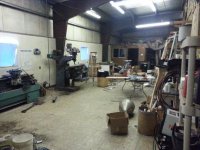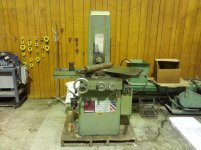Hi mtparker18:
I do a LOT of mold repair welding, so I know the business quite well by now.
The laser welder is the most important machine I have for repair, because most of what goes wrong with molds involves metal that's either been displaced from where it belongs and can't be pushed back (a bash on the parting line would be a good example), or it's been worn away (often by glass filled materials), or fractured away (a crunch with a short shot or mold timing mistake).
Before the days of laser welding, a very common way to tackle these problems was to drill a hole at the site of a localized defect, pound in a plug with Loctite on it, and then re-shape the protruding bits of the plug to restore the defect.
It was crude as hell, time consuming and not always successful.
If the plug was not bottomed out perfectly in the hole, the plug would sometimes extrude from entrapped air expansion when the mold got hot.
If the fit wasn't perfect, you could see the joint line on the plastic part.
If the trimming was too enthusiastic, the cavity could be instantly wrecked beyond redemption.
There were lots of places it couldn't be done, like around ejector pins or in close proximity to cooling lines.
Another common attempt at repair was to peen up a squash to try to drive the metal back where it came from.
This was also a hit or miss proposition with sometimes the unfortunate consequence of making the problem worse rather than better, and it always made the mold look like a pig's breakfast from all the peen marks around the defect.
A third common tactic was milling out a pocket and bolting in a patch, with problems and limitations similar to the plug method.
A fourth tactic was to regrind and refit the mold by milling or grinding away worn parting surfaces, and then shimming the inserts back up into position and re fitting ejector pins or grinding the buttons under the ejector plate or whatever was needed to get the revised parting surfaces to shut off properly again and get the mold to close properly with the pins at the proper length.
As you can imagine it's a helluva lot of work and costs a fortune.
A fifth tactic was to get the local TIG genius to try to lay a tiny bead into the defect without wiping out other features and warping the mold all to hell from the heat.
There were a half dozen guys around in North America who were really good at it, and they were GODS!!
An awful lot of that kind of repair is rendered obsolete with good welding repair technique using a laser welder.
If you care to, you can have a look at some mold repair work on my website if you click on this link:
Implant Mechanix ? Design & Innovation » Laser Micro Welding
Click on the photos to enlarge them.
So the welder is a really basic piece of equipment for mold maintenance and is well worth its cost if you have lots of this kind of work to do.
They're expensive when new (about 40 grand for an entry level German machine); I bought mine on Fleabay for 11 thousand and put another 5 thousand into it to get it fixed.
It's so very worthwhile, but it's hard to justify unless you do a fair bit of it.
I bought mine because it was an irresistable toy for me, but it's paid off rather well, mostly because there are not many around so it sets my shop apart from my competitors.
If your weld shop is really good, and can do laser and Micro TIG, you're all set, but they have to be mold welders, not just good TIG welders with conventional Lincolns and Millers in the shop.
The other relevant point is that when I've done a repair, the overwhelmingly most common other machine tool I bring to the repair is the surface grinder.
I might mill 5% of my welds, EDM 1% of my welds and surface grind 90% of the welds that don't just get stoned, filed, or hand ground with the pencil grinder under the microscope to bring them back into tolerance.
Properly placed, the majority of welds that don't result from a really big crash are so tiny, they don't need much work to dress them down.
I can easily put a weld onto a parting edge that sticks up only a couple of thou; a good touch with a fine India stone and I'm back in business in a couple of minutes.
So if your primary aim is to keep your molds running and the parts that come out of them looking like they were made in a civilized country, a good laser welder, whether yours, or your friendly mold welding shops will be the most useful asset for most of your work.
Cheers
Marcus
Implant Mechanix – Design & Innovation - home
Vancouver Wire EDM -- Wire EDM Machining



